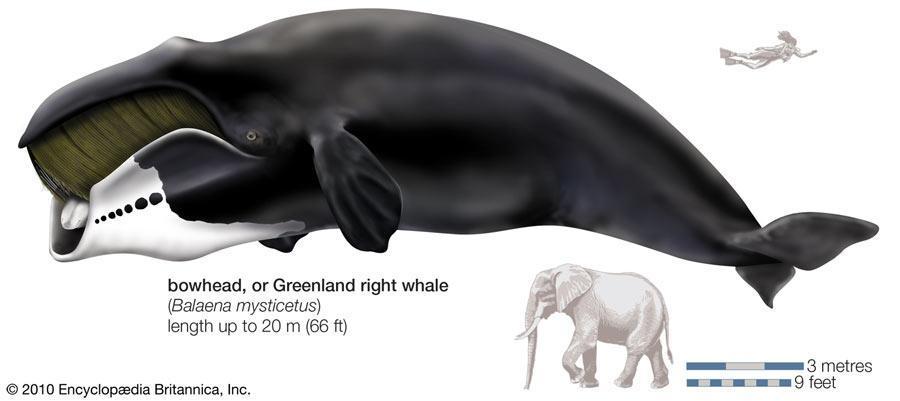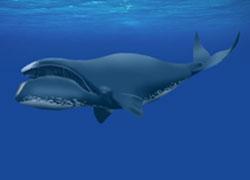Bowhead Whale
The bowhead whale (Balaena mysticetus) is a baleen whale of the right whale family Balaenidae, in suborder Mysticeti and genus It was also known as Greenland right whale or Arctic whale. American whalemen called it the steeple-top, polar whale, or Russia or Russian whale.
The bowhead whale is so-called because of its bow-shaped mouth and is black in colour with a whitish chin patch , broken by a 'necklace' of black spots.
Balaena lives entirely in fertile Arctic and sub-Arctic waters, unlike other whales that migrate to feed or reproduce to low latitude waters. They spend most of the summer in relatively ice-free waters of seas adjacent to the Arctic Ocean. They are associated with sea ice the rest of the year.
A stocky dark-colored whale without a dorsal fin, it can grow to 20 m (66 ft) in length. This thick-bodied species can weigh 75 tonnes (74 long tons; 83 short tons) to 100 tonnes (98 long tons; 110 short tons), second only to the blue whale, although the bowhead's maximum length is less than several other whales. The bowhead has the largest mouth of any animal.
The diet consists of planktonic crustaceans, which are filtered through the baleen plates. Bowhead whales often skim-feed on the surface of the sea but also gather food from the sea floor.
Historically threats to the health and lives of the animals have been:
Commercial harvest
- Targeted by hunters because they are slow and big, with large amounts of blubber
- Pursued by European and American commercial whalers for lamp oil and baleen
- North Atlantic stocks were hunted commercially for almost four hundred years, beginning in the 15th or 16th century
- Commercial hunting of bowheads in the North Pacific started when they were discovered there in the 1840s
Current threats to the health and lives of the animals are:
- Ship strikes
- Entanglement in fishing gear
- Contaminants
- Anthropogenic noise, especially from offshore oil drilling
The historic worldwide abundance of bowhead whales prior to commercial exploitation is estimated at about 30,000-50,000. The bowhead was an early whaling target. Its population was severely reduced to 3,000 by the 1920s before a 1966 moratorium. Current abundance is estimated between 7,000 and 10,000 animals worldwide, down from an estimated 50,000 before whaling.
Call us and schedule your listing today! Contact Us
Copyright © 2025 Hermanus Online Magazine. Web Development by Jaydee media.


